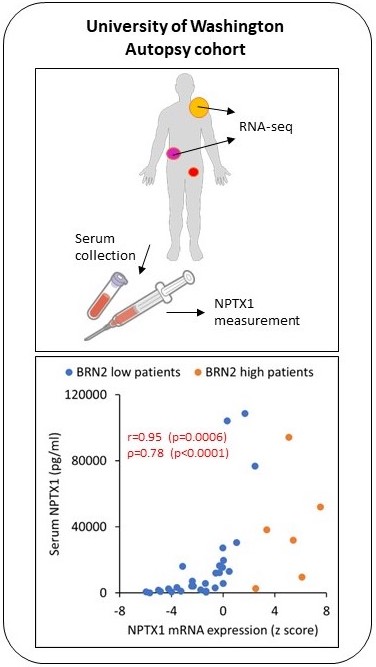Prostate Cancer
Therapeutic Targeting of Neuroendocrine Prostate Cancer



Posted September 15, 2023
Amina Zoubeidi, Ph.D., University of British Columbia

Prostate cancer is typically treated through hormonal therapies that target androgen receptor (AR) pathways, limiting the amount of testosterone the body produces. In some cases, the cancer develops resistance to AR therapies and develops into castration-resistant prostate cancer (CRPC). Alternative AR-signaling inhibitors, such as enzalutamide (ENZ), have been developed and used to treat CRPC; however, in about 25% of cases, the tumors further develop into neuroendocrine prostate cancer (NEPC), which no longer responds to AR signaling inhibitors and has very limited treatment options and a median survival time of only 7 months.1 Additional research examining the connection between CRPC and NEPC must be conducted.

With the support of a fiscal year 2017 Prostate Cancer Research Program Idea Development Award, Dr. Amina Zoubeidi and her team conducted a study to examine the biological changes in prostate cancer patients whose tumors evolved from CRPC to NEPC. Previous work by the study team determined that the protein BRN2 becomes expressed after AR inhibition and can drive the transition from CRPC to NEPC. The team was subsequently interested in identifying possible markers for BRN2 that could aid in identifying NEPC patients.
The team identified regions of DNA that BRN2 reproducibly binds to, as well as nearby genes that might consequently be regulated by BRN2, and then narrowed this list of putative BRN2-regulated genes down to 51 genes that encode proteins that are more likely to be present in patient blood. Using publicly available prostate cancer patient data, the team correlated expression of the gene candidates with BRN2 gene expression, identifying neuronal pentraxin 1 (NPTX1) as the primary candidate to serve as a serum marker for BRN2-positive NEPC patients. The team confirmed the ability to detect NPTX1 protein in NEPC cell culture media, in blood samples from a mouse model of human NEPC, and in serum from patients who died of prostate cancer, including pathologically confirmed NEPC cases. Moreover, serum concentrations of NPTX1 positively correlated with tumor volume in the mouse model and with NPTX1 gene expression in both the mouse model and tumor tissue from the human patients (in whom the tumor volume was unknown). In addition, three out of four human subjects with AR-negative NEPC had higher serum concentrations of NPTX1 than 18 out of 20 AR-positive CRPC patients. Healthy human controls had very low serum NPTX1 concentrations compared to all CRPC and NEPC patients. Work is ongoing in the Zoubeidi Lab to validate these findings.
NPTX1, the candidate BRN2-positive NEPC serum marker identified by Dr. Zoubeidi's study, could be used in a diagnostic setting to help guide prostate cancer patient selection for future NEPC clinical trials. Further research is needed to strengthen the relationship between the NPTX1 marker and NEPC, as well as to determine how NPTX1 can be used in conjunction with BRN2 inhibitors, to provide new options for patients who develop this deadly subtype of prostate cancer.

References:
1Zhu J, Liang X, Wu D, et al. 2021. Clinicopathological characteristics and survival outcomes in neuroendocrine prostate cancer: A population-based study. Medicine (Baltimore) 100(15):e25237. https://doi.org/10.1097/MD.0000000000025237
Publication:
Thaper D, Munuganti R, Aguda A, et al. 2022. Discovery and characterization of a first-in-field transcription factor BRN2 inhibitor for the treatment of neuroendocrine prostate cancer. bioRxiv. https://doi.org/10.1101/2022.05.04.490172
Link:
Public and Technical Abstracts: Therapeutic Targeting of Neuroendocrine Prostate Cancer
Last updated Monday, March 10, 2025














